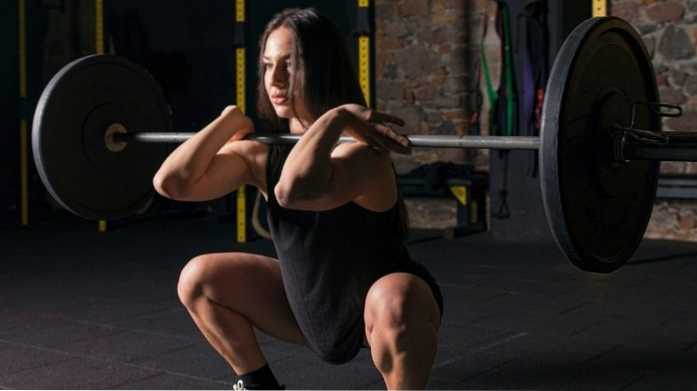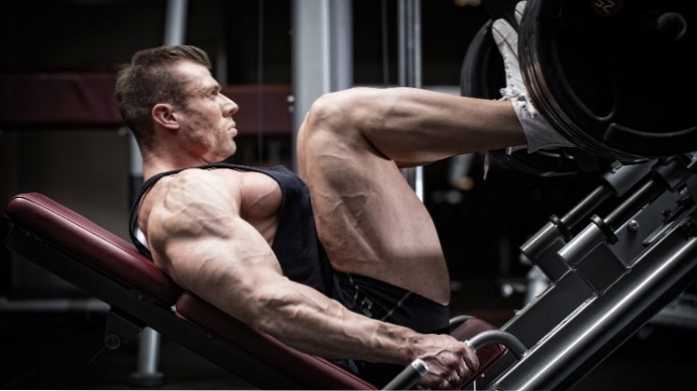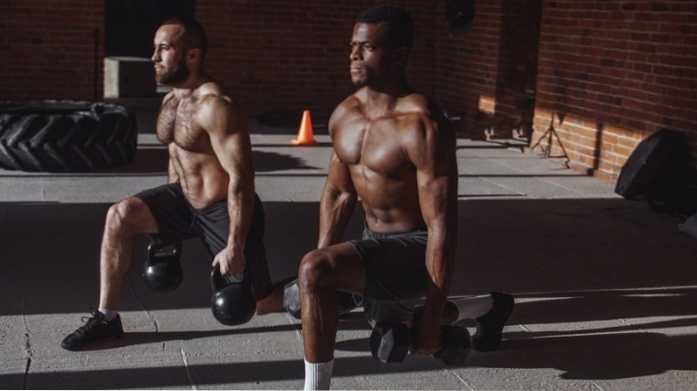
The Best Leg Exercises For Muscle, Strength, and More

You did not hear it here first, but it bears repeating: train your legs. Leg day can be a painful, DOMS-inducing experience but ignoring your lower half also robs the body of more muscle, enhanced movement, and increased calorie burn. Also, do you want to look like Hercules upstairs and Chicken Little from the waist down?
To further enlighten you to the benefits and, dare we say, the fun of training your legs, we compiled a list of the best leg exercises. Further down, we also dive into the benefits of leg training. There are plenty.
The Best Leg Exercises
- Front Squat
- Bulgarian Split Squat
- Leg Press
- Romanian Deadlift
- Nordic Hamstring Curl
- Reverse Lunge
- Barbell Hip Thrust
- Prowler Push
Right off the bat, you're going to notice two things: First, all of the moves on this list are compound exercises or movements that involve more than one joint. While isolation exercises - such as lying leg curls and leg extensions - have a place in training, compound moves recruit more muscle and, generally, carry over better to our everyday movement patterns.
Second, the back squat isn't on this list. Every powerlifter probably just spewed their creatine drink all over the screen after reading that sentence, but hear us out. For most people, the front squat is a better squat option, and we'll explain why.
Front Squat
Powerlifters need to back squat because they're required to in competition. That said, everyone else may want to consider ditching this squat variation for its front-loaded brother, the front squat. One benefit of front-squatting is that the lifter is forced to use lighter weight since a person isn't as strong in the front-rack position. Because of this, the exercise is inherently safer for the spine. You can't cheat it easily, either. If you can't support the weight in front of you, then you simply can't and you'll be forced to dump it. With back-squatting it's more common to see lifters quarter-repping weight that's far beyond their ability. Lastly, the front squat requires more thoracic stability and forces the lifter in an upright position, which is better for core recruitment and posture.

Benefits of the Front Squat
- The front squat is safer than a back squat as the weight is loaded in front of the body.
- The front-loaded position recruits more of your core and strengthens your upper back muscles to improve your posture, too.
- This move does not allow lifters to load the exercise too heavy, as they'll be forced to drop the bar.
How to Do the Front Squat
Set a barbell in a power rack to shoulder height, loaded with an appropriate weight. Extend your arms directly out in front of you so that your hands are touching the bar. Place your middle three fingers on the bar and then drive your palms up, bring your elbows underneath the bar so that they're pointing straight forward. The bar should be resting across your upper chest. For lifters who lack the mobility to get into this position, another alternative starting position is to rest the bar on your collarbone (which hurts, yes) and cross your arms, so they're touching the opposite shoulder. This position is called the genie rack position. Step back, so the bar is out of the rack and keep your elbows pointing forward. With your chest up, squat down until the bottoms of your thighs are parallel to the floor. Now, drive back up through your heels.
Bulgarian Split Squat
Elevating your leg on a bench creates instability and increases the exercise's range of motion. The Bulgarian split squat's instability forces you to balance, which recruits smaller stabilizing muscles in your hips and quads. Squatting with a more extended range of motion increases the muscle's stretch - enhancing your mobility and the muscle-building tension placed on the glutes, hamstrings, and quads.
Benefits of the Bulgarian Split Squat
- The increased range of motion for more mobility and muscle recruitment.
- The Bulgarian split squat creates instability, which recruits smaller stabilizing muscles.
How to Do the Bulgarian Split Squat
Hold a dumbbell in each hand and stand about a foot in front of a bench. Place one foot, laces down, on a bench. Brace your core and squat down until both of your legs bend to 90 degrees. You can squat down a little further, but don't let your knee touch the floor. Hold this down position for a beat and then drive back up.
Leg Press
The leg press doesn't have you load your torso with weight and your back braces against a pad, which gives you more driving force. As a result, you can load this exercise up with more weight relative to most leg exercises. This factor makes the leg press a great accessory to getting bigger and stronger thighs. It's also safer as you can rack the sled simply but turning the handles in and out. As a bonus, you can more quickly load and unload the leg press, making it useful for drop sets. You can perform a high-rep set, strip the plates, do another set, strip the plates, and so forth.

Benefits of the Leg Press
- You can press heavier weights with just your legs.
- The leg press allows you to essentially perform a squat but without the weight bearing down on your spine or torso.
- This is a great movement for high-rep sets and drop sets.
How to Do the Leg Press
Sit in the leg press seat, and place your feet in the middle of the sled, about shoulder-width apart. Press the sled out of the rack, lower the safety bars, and then slowly lower the sled towards your chest until your thighs break 90 degrees. Press the sled back up but do not lockout your knees. If your lower back or hips are lifting off the seat as you drive the weight back up, you're using too much weight.
Romanian Deadlift
This deadlift variation is nearly identical to the standard deadlift, except that you lower the weight to mid-shin level. Therefore, you use less weight and lift with greater control. The Romanian deadlift helps you build muscle, improve your regular deadlift, and strengthens your hips and lower back - which results in a lesser chance of injury performing similar movements.
Benefits of the Romanian Deadlift
- The Romanian deadlift forces you to lift lighter weight with more control, strengthing your hips and lower back.
- This move will carry over to your traditional deadlift.
- The slow and controlled movement will help to build more hamstring muscle.
How to Do the Romanian Deadlift
Load a barbell up with less weight than you would for a traditional deadlift, but get in the same deadlift position - feet shoulder-width apart, and hands gripping the bar just outside the knees. Raise your chest up and then drop your hips and pull up on the bar until your hips are fully locked out. Now, push your hips back, keep your back straight, and lower the bar until it's in the middle of your shins. You should feel a stretch in your hamstrings.
Nordic Hamstring Curl
This bodyweight hamstring curl has you kneel, with your feet anchored behind you, and lower your body towards the ground by flexing only your knees. This puts the onus on the hamstrings, and the hamstrings alone, to support your body weight. The Nordic hamstring curl is an excellent move to build muscle and prevent injury. One study in the Journal Physiotherapy had 50 elite soccer teams in Denmark complete their usual hamstring training for 10 weeks during a mid-season break. Half of the teams added two to three sets of five to 12 reps of Nordic hamstring curls one to three sessions per week. During that season, the group that added the Nordic curls had 15 total hamstring injuries compared to 52 in the non-Nordic curl group. (1)
Benefits of the Nordic Hamstring Curl
- More muscle as you're targeting primarily your hamstrings with your bodyweight.
- Less risk of hamstring injury as eccentric (or lowering) strength has been linked to healthier hamstrings.
How to Do the Nordic Hamstring Curl
Anchor your feet underneath something sturdy - a loaded barbell, a bench, the legs of a cable machine - and kneel on a yoga mat. Extend your arms out in front of you, keep your torso straight, and bend at the knees to slowly lower yourself towards the floor. The lower you get, the harder the move will feel as you're further from the anchor point. Catch yourself with your hands, and then push your body back up to the starting position.
Reverse Lunge
Like any lunge, the reverse lunge is a unilateral exercise, which means it works one side of the body at a time. This alone is useful as it allows the target muscles (glute, hamstrings, and quads) of your body to catch up to another if right or left side dominant. The reverse lunge is also more stable than the forward or walking lunge as you're not being thrown off balance by forward momentum. Instead, the reverse lunge is a generally more controlled move. The stability of this lunge makes it great for both beginners and advanced trainees who want to add weight to the movement - you'll have an easier time loading a reverse lunge.

Benefits of the Reverse Lunge
- It's easier to control compared to other lunge variations, making it beginner-friendly.
- You'll work one side of the body simultaneously, allowing lagging muscles to play catch up.
- Advanced lifters can load up this lunge variation more safely than others as it's stable.
How to Do the Reverse Lunge
Stand with your feet together, and keep your hands at your sides or on your hips. Take a step back with one leg until it's behind you, and your knee is an inch or so above the floor. Your front leg should bend at a 90-degree angle as well. Keep your chest up and facing forward. Now, drive through the balls of your back foot and stand back up with control.
Barbell Hip Thrust
There are a few major benefits to the barbell hip thrust. For one, you can directly target your glutes, which are usually an auxiliary player in moves like the lunge, squat, and deadlift. Also, it helps strengthen your hip extension mechanics, since that's the primary function of the movement. Lastly, stronger glutes mean you'll rely less heavily on your lower back for most related exercises, and so you should reduce your chance of low back injury.
Benefits of the Barbell Hip Thrust
- You can directly target your glutes, more so than any other exercise, which will carry over to other exercises that require glute strength.
- Stronger glutes will take some of the mechanical stress off of your lower back, which can reduce the chance of injury.
- Seeing as the barbell hip thrust is a hip extension exercise, you'll get far better at hip extension - and that also benefits other moves like the deadlift and squat.
How to Do the Barbell Hip Thrust
Load a barbell with rubber plates (if possible), as you want the bar higher up off of the ground. Now, roll the barbell towards you so it's sitting on your hips. Place your upper back on a bench and bend your knees with your feet flat on the floor. Squeeze your glutes and drive your hips up, holding onto the barbell with both hands to prevent it from falling, until your body is in a straight line from knee to chin. Hold this position for a beat and then lower the weight back down.
Prowler Push
You probably think that the prowler push is strictly for conditioning and not a leg movement. At the very least, even if you know of its lower-body benefits, you're probably wondering what it's doing on our best leg exercises list. The driving force behind a prowler push is your legs. If you load up a prowler with heavy weight, you're taxing your legs and eliciting a strength and hypertrophy response. It's also a less taxing on your back, as you're bracing against the prowler with your upper body - nothing is sitting on you. Pushing a prowler also translates directly to your ability to sprint and run as you're in the same position while pushing the prowler.
Benefits of the Prowler Push
- Allows you to tax your legs with heavy weight without stressing your lower back.
- Improves your sprinting mechanics, as you're strengthening your legs in a more natural running position.
How to Do the Prowler Push
Load a prowler up with as much weight as you can handle for multiple sets of pushes. Stand in front of the poles, extend your arms, and grab them with your hands. Now, lean into the prowler until so your arms are bent and your shoulders are nearly touching the poles. Your body should be at an angle with your feet behind you, as if you were leaning into a sprint. Drive the prowler forward by pushing with your legs, and continue to move your legs in a slow and rhythmic motion.
The Benefits of Training Your Legs
There are plenty of reasons to train your legs: Leg training improves one's ability to explode; leg exercises burn more calories; leg muscle is aesthetic; and, all of the movements on this list will help you move better overall. Here, we'll dig deeper into the reasons why one shouldn't skip leg day.
You'll Become More Powerful
Almost every full-body movement starts from the ground up - sprinting, jumping, even throwing a punch. So it reasons that strengthening your legs will result in more effective movement all around. One study published in the Journal of Sports Medicine had 20 athletes perform four sets of 10-rep max back squat twice a week for six weeks to see how it affected their strength and power output. After six weeks, the subjects improved their leg press strength, countermovement squat jump performance, and the pendulum sprint. (2)
You'll Burn More Calories
There are a lot of factors in play when determining how many calories a person burns per exercise - like their weight, height, body fat percentage, how hard they're working, and so on. It turns out, which exercise you choose matters, too. A 2017 study in the journal PLOS One measured which the calorie-burning effect of eight exercises (three lower-body moves and five upper-body moves). The researchers divided 58 males into four groups and assigned two exercises per group. The subjects performed a five-minute-long constant intensity set with as much as 24% of their one-rep max. They then performed “exhaustive bouts” with 80% of their one-rep max. The results showed that the leg exercises (half-squats, leg press, and leg extensions) performed with 80% of one's one-rep max, produced up to 20 calories burned per minute. (3)
You'll Be More Symmetrical
You don't need a fancy study to tell you that if you don't train your legs, they won't grow - and then, what, you'll be the guy with biceps the size of his thighs? Even if you never plan to compete in a bodybuilding show, there's an aesthetic benefit to having muscular legs to go along with your chest, back, shoulders… you get the idea.
Leg Training Can Improve Your Ability to Move
Aside from moving more quickly and powerfully, training your legs can improve your everyday mobility. Though you think you're only hip-hinging or squatting when you're in the gym, that's not the case. Any time you bend over to pick something up, you're hinging at the hips. If you get up and down from a chair, you're squatting. Heck, walking down the stairs is essentially a lunge. See the point? The squats, lunges, and deadlifts you perform in the gym will, over time, make you stronger and more proficient at the movements we engage in daily.
This is especially true as we age. The older one gets, the weaker they can become and, as a result, less coordinated and mobile. An analysis of studies on PubMed that explored the effects of strength training in the elderly concluded that strength training in the senior population can reduce sarcopenia (or muscle loss) and retain motor function. (4)
More Leg Training Tips
The benefits of leg day go far beyond this article. After all, there are more than eight moves to train your legs with and a myriad of ways to apply them to your training. Click on the links below for more information on training your legs.
- 10 Unconventional Squat Variations to Build Stronger Legs
- Best Foam Roller Exercises for Legs
References
- Schache A. Eccentric hamstring muscle training can prevent hamstring injuries in soccer players. J Physiother. 2012;58(1):58. doi: 10.1016/S1836-9553(12)70074-7. PMID: 22341384.
- Wirtz N, Zinner C, Doermann U, Kleinoeder H, Mester J. Effects of Loaded Squat Exercise with and without Application of Superimposed EMS on Physical Performance. J Sports Sci Med. 2016;15(1):26-33. Published 2016 Feb 23.
- Reis VM, Garrido ND, Vianna J, Sousa AC, Alves JV, Marques MC. Energy cost of isolated resistance exercises across low- to high-intensities. PLoS One. 2017;12(7):e0181311. Published 2017 Jul 24. doi:10.1371/journal.pone.0181311
- Mayer F, Scharhag-Rosenberger F, Carlsohn A, Cassel M, Müller S, Scharhag J. The intensity and effects of strength training in the elderly. Dtsch Arztebl Int. 2011;108(21):359-364. doi:10.3238/arztebl.2011.0359
Feature image courtesy of UfaBizPhoto/Shutterstock



Nimeni nu a comentat acest articol încă.